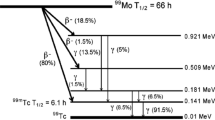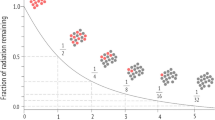Abstract
Nowadays, the radioactive wastes production is certainly one of the main issues along with their storage. The most interesting way to treat them would certainly be the radioactivity reduction. In this paper we show that the 63Ni radioactivity reduction by ultrasounds is not a violation of the exponential decay law but can be explained by the Deformed Space–Time theory. The cavitation procedure under the DST conditions achieves a radioactivity decrease around 14% in 200 s. Comparing these results with the theoretical ones obtained by the decay law, we earn more than 20 years in the 63Ni radioactivity decrease. For confirming the data, ICP-MS measurements were performed on cavitated and no-cavitated samples: once again, the 14%-difference (with CV 5%) was obtained from the analyses of both samples. Even if the data are not definitive, the new idea is that a radioactive substance can be “normalized” by its transformation into a normal stable one without radiation emission overcoming the traditional approaches (dilution, inertization, radioactive transmutation with fast neutron irradiation) and avoiding the use of large deposits or big reactors. Our results may be considered as starting point to pave the way to new methods to treat useless harmful radioactive substances from nuclear or medicine industry.
Similar content being viewed by others
1 Introduction
The management of radioactive waste is one of the main problems for the to-day mankind: during these last decades expensive and hard-realization proposals for achieving minor actinides burning or radionuclide transmutations have been proposed by International agencies [1]. At the moment, the deactivation mainly consists in mechanical processes, mainly the inertization where the waste is incorporated into a large volume of material, or using living organisms, e.g., Ralstonia detusculanense, an archaebacterium [2] able to significantly reduce the radioactivity of radionuclides coming from fission reaction (e.g., Co-60, Sr-90, Cs-135, Cs-137). Further, this crucial problem, i.e., reducing the radioactivity of nuclear (sanitary and industrial) wastes, has also mainly been addressed through the use of two main methodologies: mechanical and chemical-electrochemical methods. However, these methods do not modify the radioactivity of the single radionuclide but limit themselves to separate the radioactive fraction from all the rest of the material and, possibly, to concentrate it. In this way, the deactivation of a radioactive substance consists in incorporating it in a large volume of inert material: the result is a radioactivity decrease per unit of volume but the total number of radioactive nuclei is unchanged [3, 4].
Sugihara [5] proposed a treatment based on water at high pressure for deactivating fission products in radioactive soil/waste. All these procedures appear remarkable even if the theoretical bases are either not clear or not defined at all. The theories involved for justifying the radionuclide deactivation are different: the biquaternion quantum mechanics proposed by Conte [6], the Giuliano Preparata’s hypothesis [7], the Infoton theory by Brillouin [8] and Dirac [9], the Widom and Larsen [10] implemented by Srivastava et al. [11], the electronic density increase hypothesis [12], the nuclear lattice model by Dallacasa and Cook [13]. The common background for all these theories is the standard model of particle physics, under strict conditions and absolute observation both of the Minkowski space–time and of local Lorentz invariance. The problem is that they do not manage to explain some fundamental evidences, i.e., constant lack of radioactivity (γ radiation) and radioisotopes, formation of stable natural isotopes, modification of natural isotope ratio and anisotropic and asymmetric neutron emission [14,15,16,17,18].
The approach proposed in this paper follows the Deformed Space–Time (DST) theory, in not Minkowski conditions, in local Lorentz invariance breakdown [19, 20]; it is based on measurements of neutron and alpha emissions during different experiments without radioactivity production (i.e., gamma rays) [21,22,23].
2 Materials and methods
25 mL of 63Ni(NO)3 solution in nitric acid, after addition of 5 mL of ultrapure deionized water (resistivity 18 MΩ × cm−1) (total solution volume 30 mL, weight 39.6 g, density 1.32 g × cm−3), were subjected to cavitation process employing an Ergal 7075 sonotrode. This sample (i.e., 63Ni(NO)3) is quite similar to a real sample, the nuclide is a part of a molecule also containing other elements. This occurrence allows to extrapolate experimental conclusions to be extended to other applications. For instance, the sample is very corrosive, well simulating the case of nuclear wastes, either of industrial or sanitary source, that are the most critical to be treated. Thus, the reported experiment can be considered as a good test for future applications in severe conditions: radioactive and corrosive samples. The Ergal sonotrode is made of Al/Zn/Mg/Cu alloy with the following composition: Al 87.3–90%, Zn 5.1–6.1%, Mg 2.1–2.9%, Cu 1.2–2%, other elements are Fe, Mn, Si, Cr, Ti, Zr, 1.6–1.7%; its sizes are: height 85 mm, base diameter 30 mm, tip diameter 5 mm, according to the local Lorentz invariance breakdown rules for the DST reactions. The particular sonotrode shape and the angle between the vessel and the sonotrode are important experimental information and derive from our previous studies. Actually, the shape is well-described above whereas the angle cannot be reported because such data is the main frame of a patent pending. The sonotrode was immersed in the solution with the tip 4.5 mm far from the bottom of the vessel: an ultrasound generator produced ultrasounds at 35 kHz, 15 W transferred power and with a vibration amplitude of 7 µm. Two cavitation runs of 100 s, separated by a cooling interval of 5 min, were performed. Bremsstrahlung measurements were carried out by means of an X-gamma ATOMTEX AT6102 spectrometer equipped with a NaI detector, on the samples before/after cavitation using the same counting geometry (sample-detector distance 0.5 cm). A non-cavitated sample of equal volume (30 mL), weight (39.6 g) and density, was prepared in a similar vessel and measured in the same operating conditions, was used as blank solution. Furthermore, as a double check inductively coupled plasma-mass spectrometry (ICP-MS) measurements (Agilent mod. 7000) were carried out on all the samples (cavitated samples) and the references (non-cavitated samples).
3 Results and discussion
Before approaching the results, the choice of 63Ni should be addressed. The 63Ni is a beta negative emitter with a half-life of about one hundred years (101.2 ± 1.5 years): the bremsstrahlung of the beta radiation leads to an X-ray with a maximum of energy at 66 keV (end point).
Figure 1 reports the spectra of the background and of the sample before and after cavitation procedure.
As it can be seen, the useful field energy ranging between 0 and 66 keV does not show any interferences in the background whereas a clear decrease before and after cavitation (from 2380 counts to 2046 counts after two cavitation runs, with a coefficient of variation, cv%, of 4.6% and 5.4%, respectively) of the 63Ni radioactivity can be evidenced, with a maximum peak around 30 keV (i.e., the average energy of the γ emitted) (Fig. 2). Different tests were carried out for attesting this decrease and obtaining a statistical trial: varying the cavitation time and the time interval between the two different cavitation procedures such decrease ranges between 13 ± 6% and 14 ± 6%.
A confirmation of this occurrence has been proved analyzing the same samples by means of ICP-MS: the mass spectrometry tests performed on blank and samples before and after cavitation have confirmed a decrease around 14%. Simultaneously, an interesting detection of an increasing of non-radioactive nuclides (e.g., 59Co, 7Li, 9Be, 11B) has been detected (Table 1).
This occurrence is important because, confirming what reported by Metzler et al. [24] about the absence of energetic nuclear radiation (the authors studied the decay of nucleus 57Co into 57Fe), it strengthens data obtained by our experiments. Further, it could appear as a confirmation of the DST theoretical hypothesis: during the ultra-sound cavitation treatment of material containing radioactive species (e.g., fission products, reactor wastes, radiogenic materials used in medical applications): a radionuclide transformation evidenced by a clear radioactivity decrease is obtained. The observed phenomenon cannot be considered a bioconcentration process, neither a radionuclide confinement nor a nuclear transmutation, neither a decay time acceleration. We called it “Normalization of the radionuclide”, meaning the occurrence of a nuclear transformation reaction under the Deformed Space–Time conditions: the transformation of a radioactive nucleus into a stable non-radioactive nucleus without radioactivity emission.
The strict observance of the experimental conditions/parameters following our experiences performed on the basis of the DST theory, is fundamental for the experiment success. Previous experiments performed by means of electromagnetic field variation and neutron emission measurements, showed that there are preferential and privileged spatial directions within which the phenomenon occurs and is able to maintain itself [23]. Outside of these conditions, the phenomenon does not occur, or occurs in a weak way, or is not maintained. In the experiment reported in this paper, the angles formed by sonotrode with the vessel and with the ultrasound transmitter were chosen to give the neededand privileged spatial directions. In this way, the reaching of an exact energy density and intensity according to the sources and material used (e.g., ultrasounds, electromagnetic waves, spark source ionization) is an important starting point as well as its constant maintenance, the threshold time for triggering the process, the temporal and spatial sonotrode symmetry in relationship to the correct energy administration and, finally, the presence of DST micro-reactors (bubbles) within the treated material [25]. The addition of 5 mL of fresh ultrapure deionized H2O (Resistivity 18 MΩ × cm−1) to 63Ni(NO)3 solution was deliberately performed for creating the correct conditions for the formation of micro reactors, i.e., bubbles with a diameter not exceeding 10 µm. These conditions allow to occur the DST reactions, as shown in our previous paper [26, 27] both for liquids/solutions, and for solid state materials.
As reported above, this normalization “causes” an average radioactivity decrease of 14% among the experiments. For getting an idea about the results obtained, Fig. 3 shows the 63Ni natural decay both under normal working conditions and after cavitation process.
63Ni has a life-time of 101.2 ± 1.5 years: it means that, for obtaining the radioactivity decrease recorded by our experiments, more than 20 years would be needed (dotted line) whereas two moderate cavitations of 100 s were sufficient to achieve more remarkable results (solid line). The step-down between the two lines is really evident at the beginning, i.e., when the cavitation produces its effects on the material. From this point on, after the end of the cavitation effects that shortened the decay of 22 years, the radioactivity asymptotically decreases down to the dotted line according to the exponential decay law. It should be noted that the step-down is only due to the radioactive nuclei reduction, which means that the decay constant is not modified by the cavitation process.
Briefly resuming, three issues are noteworthy to be stressed. First, the result confirmation already achieved in thorium experiments [22] showing the same behavior as in nickel: the radiation reduction exactly matches the radionuclide reduction. Second, the time elapsed between the thorium and the nickel experiments has been fulfilled by the mercury metamorphosis experiments [25] which, together with the neutron asymmetry emission experiments, allows to understand the right coupling between sonotrode and vessel as well as their right shapes and dimensions. Third, here is shown another proof that in Deformed Space–Time reactions the use of a privileged angle is fundamental (together with the energy thresholds and energy densities) in order to start and sustain the reaction regardless the material (radioactive or stable) subjected to.
4 Conclusions
The considerations here reported pave the way to new methods to treat useless radioactive substances (e.g., wastes) from nuclear or medicine industry. The data obtained are precise and accurate but not definitive. The present experiment confirms the existence of the phenomenon, which must be verified by means of further tests. We stress that the normalization of a radioactive substance induced by DST reactions, is only due to its transformation in stable elements and neither to any alteration of the radioactive decay law nor to a leptonic interaction deviation. In future studies, the main objectives should be either both the use of other radionuclides (α, β and γ emitters) at well-defined specific activity, either the statistical quality improvement of the results either the control of the transformation products. The large idea is to extend the applications of the DST theory to the main elements involved in the radiological wastes, e.g., transuranic elements or fission products (137Cs). Finding these extension means to have a powerful tool for addressing studies of radioactivity removal. If nuclear wastes are well-known issues, the medical wastes, both radioactive and no-radioactive, will be one of the main target in the future according to the great daily disposals created by all the hospitals worldwide. All the reported uses are only the main applications but the scenarios that could open up are substantially so big to include, for instance, the treatment of industrial wastes and garbage.
References
Fokau A, Zhang Y, Ishida S, Wallenius J (2010) A source efficient ADS for minor actinides burning. Ann Nucl Energy 37:540–545
Vysotskil VI, Shevel VN, Tashirev AB, Kornilova AA (2003) Successful experiments on utilization of high-activity nuclear waste in the process of transmutation in growing associations of microbiological cultures. In: Proceedings of 10th international conference on cold fusion, Cambridge, MA, USA; pp 121–125
Shcheklein SE, Shastin AG, Domanskaya IK (2014) Prospects of the application of curable decontamination solutions in problems of impact improving of nuclear power plants. In: Brebbia CA, Magaril ER, Khodorovsky MY (eds) Energy production and management in the 21st century, vol 2. WIT Press, Ashurst, pp 927–933
Rahman ARO, Ibrahium HAS, Hung YT (2011) Liquid radioactive wastes treatment: a review. Water 3:551–565
Sugihara S (2013) Deactivation of radiation from radioactive materials contaminated in a nuclear power plant accident. Water 5:69–85
Conte E (1997) On a generalization of the pysical laws by biquaternions. An application of the generalization of Minkowski space–time. Phys Essays 10:437–441
Fleischmann S, Pons S, Preparata G (1994) Possible theories of cold fusion. Nuovo Ciment A107:143–156
Brillouin L (1960) Wave propagation and group velocity. Academic Press, New York. ISBN: 9781483276014
Dirac PAM (1938) Classical theory of radiating electrons. Proc R Soc A Math Phy 167:148–169
Widom A, Larsen L (2008) Insight from the stars. In: Krivit S (ed) Hacking the atom: explorations in nuclear research, vol 1. Pacific Oaks Press, Boca Raton, pp 265–304. ISBN 978-0996886451
Widom A, Swain J, Srivastava Y (2013) Neutron production from the fracture of piezoelectric rocks. J Phys G Nucl Partic 40:015006
Belloni F (2016) Alpha decay in electron environment of increasing density: from the bare nucleus to compressed matter. Eur Phys J A 52:32
Dallacasa V, Cook ND (1987) The FCC nuclear model (II). Nuovo Ciment A 97:184–201
Winterberger F (1984) Autocatalityc fusion-fission implosions. Atomkernenerg/Kernt 44:145–148
Derjaguin BV, Lipson AG, Kluev VA, Sakov DM, Toporov YP (1989) Titanium fracture yields neutrons? Nature 341:492
Ohmori T, Mizuno T (2000) Nuclear transmutation reactions caused by light water electrolysis on a tungsten cathode. J New Energy 4:66–78
Storms E (2007) The science of low energy nuclear reactions: a comprehensive compilation of evidence and explanations about cold fusion. World Scientific Publishing, Singapore. ISBN: 978-981-270-620-1
Mosier-Boss PA, Dea JY, Forsley LPG, Morey MS, Tinsley JR, Hurley JP, Gordon FE (2010) Comparison of Pd/D co-deposition and DT neutron generated triple track observed in CR-39 detectors. Eur Phys J Appl Phys 51:20901–20911
Cardone F, Mignani R (2004) Energy and geometry—an introduction to deformed special relativity. World Scientific Publishing, Singapore. ISBN 978-9-81-238728-8
Cardone F, Mignani R (2007) Deformed space–time. Springer, Dordrecht. ISBN 978-1-4020-6282-7
Cardone F, Cherubini G, Petrucci A (2009) Piezonuclear neutrons. Phys Lett A 373:862–866
Cardone F, Mignani R, Petrucci A (2009) Piezonuclear decay of thorium. Phys Lett A 373:1956–1958
Cardone F, Cherubini G, Lammardo M, Mignani R, Petrucci A, Rosada A, Sala V, Santoro E (2015) Violation of local Lorentz invariance for deformed space–time neutron emission. Eur Phys J Plus 130:55–66
Metzler F, Hagelstein P, Lu S (2018) Observation of non-exponential decay in X-ray and γ emission lines from Co-57. JCMNS 27:46–96
Cardone F, Albertini G, Bassani D, Cherubini G, Rosetto F, Guerriero E, Mignani R (2018) Nuclear metamorphosis in mercury: rare earths production. JCMNS 27:1–8
Cardone F, Mignani R, Petrucci A (2012) Piezonuclear reactions. J Adv Phys 1:1–34
Albertini G, Capotosto R (2016) Deformed space–time reactions: towards nuclear metabarysis. J Adv Phys 5:84–89
Acknowledgements
The authors would like to thank Prof. Albertini, Università Politecnica delle Marche, and drs. Andrea Petrucci, ENEA, Ettore Guerriero, IIA-CNR, Domenico Bassani, Sidom s.a.s., and Valter Sala, Startec, for their help in the experimental activity and useful comments in the manuscript elaboration.The authors declare no conflict of interest.
Author information
Authors and Affiliations
Corresponding author
Ethics declarations
Conflict of interest
The authors declare that they have no conflict of interest.
Additional information
Publisher's Note
Springer Nature remains neutral with regard to jurisdictional claims in published maps and institutional affiliations.
Rights and permissions
About this article
Cite this article
Rosada, A., Cardone, F. & Avino, P. The astonishing 63Ni radioactivity reduction in radioactive wastes by means of ultrasounds application. SN Appl. Sci. 1, 1319 (2019). https://doi.org/10.1007/s42452-019-1391-6
Received:
Accepted:
Published:
DOI: https://doi.org/10.1007/s42452-019-1391-6







